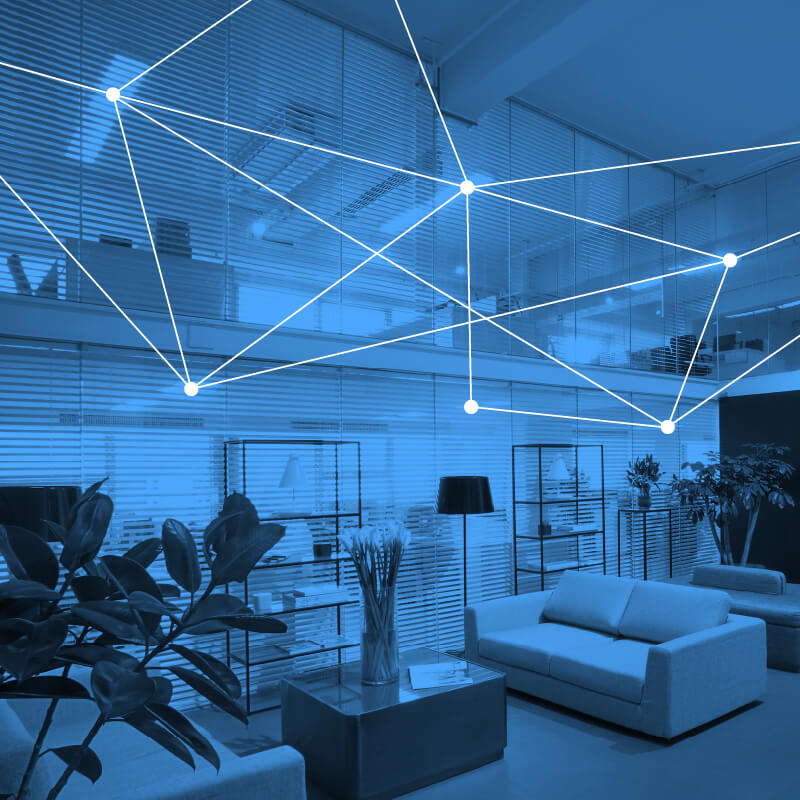9 Resources That Showcase the Realization of Bluetooth Networked Lighting Control in Large-Scale Commercial Environments
|
Earlier this year, we released an article that outlined how networked lighting control systems can deliver a combination of energy savings, an enhanced occupant experience, and more efficient building operations. Deployed in offices, retail, healthcare, factories, and other commercial facilities, Bluetooth® Networked Lighting Control systems can also enable more efficient operation of other building systems and serve as a building’s central nervous system.
While, at length, we looked at why Bluetooth wireless lighting control networks are well-positioned to take over commercial lighting, there is no better proof than real-world use cases and implementations that verify the efficacy of a Bluetooth Networked Lighting Control system.
Here are nine recent examples that showcase the realization of Bluetooth Networked Lighting Control in large-scale commercial environments.

1) Maximizing Energy Savings with Smart Lighting
This case study by Sylvania outlines how Atalian, a global leader in facilities management services, replaced their outdated luminaires with Sylvania’s Bluetooth enabled connected building solution. Capturing real-time energy consumption of the existing and the new lighting solution, Atalian can monitor the performance of the new solution and verify the achieved savings against the target ROI.
The case study states that, during the period of monitoring, switching to LED saved 50 percent on initial energy costs. The usage of Sylvania smart controls combined with precise motion detection in every fixture, daylight harvesting and task tuning, generated additional savings (69 percent on top of LED savings) to bring total energy savings to 84 percent compared to the old installation. Translated to carbon emission data, this new installation can reduce around 4t of Co2 every year without any compromise on occupant comfort levels.
“No additional cabling is required, unlike a system that is not integrated into the luminaire – this is unique,” said Abdel Hamroun, Atalian operations manager. “Also, we could easily add battery- and maintenance-free, kinetic powered wireless wall switches to rooms, to allow users adjust light levels and set scenes, simply and easily.”
2) Turning an Existing Installation into an Intelligent Light Management System
Tasked with finding a simple, quick-to-implement, and cost-effective solution to modernize an old, ailing lighting system in an office building in Kolding, Denmark, OSRAM chose a Bluetooth® enabled wireless lighting control solution. Thanks to the ease of installation inherent in Bluetooth Mesh and its decentralized architecture, the existing installation could be reused and the new system put into operation quickly and with minimal downtime. This meant that the present infrastructure could be used without costly and time-consuming rewiring and without a gateway or other complex IT elements.
Office building employees now benefit from greater comfort and convenience, and building operators can take advantage of significantly increased energy efficiency thanks to daylight control and presence detection.

3) The Largest Bluetooth Mesh Lighting Control Installation in the World
Teaming up with Silvair technology partner McWong International, Energy Management Collaborative (EMC) designed a luminaire-level lighting control solution to provide occupancy, scheduling, and vacancy control scenarios commonly used in tenant offices and open spaces. The goal was to maximize efficiency while taking into consideration how users interacted with their individual spaces.
According to the case study, the installation required 3,685 Bluetooth Mesh lighting controllers installed throughout 17 floors of a 470,000+ square-foot office building. Highlighting the power of the Bluetooth Mesh interoperable standard, at the building manager’s request, additional components were seamlessly added to the network lighting control system and worked inter-operably with the luminaire lighting controllers. Now, the installation has expanded to 3,923 Bluetooth Mesh devices over 17 floors.
Enabled by the network lighting control features, EMC deployed vacancy and occupancy scenarios for most of the project zones and, in addition, configured the high-end trim to as low as 60 percent. This combination of scenarios and settings provided expected energy savings in excess of 75 percent over and above that gained by LEDs alone. As space needs change, the new system can be wirelessly re-zoned as needed to accommodate future reconfigurations of floor layouts.
4) Energy and Cost Savings at Pioneer Markets
Pioneer Markets, a family-owned grocery business operating in Mariposa and Waterford, California, turned to LED GreenLight International LLC, a manufacturer of advanced LED lighting products, for their lighting-control expertise. LED GreenLight International LLC helped retrofit Pioneer Markets’ existing T8 lamps with a Type C LED retrofit kit consisting of 95+ CRI LED tubes and LED driver with integrated Bluetooth® Mesh for advanced lighting control features.
According to the case study, the LED Drivers, integrated with wireless Bluetooth Mesh, provide the granular control capabilities needed to implement advanced network lighting control strategies. These lighting scheduling control strategies increased energy efficiency and lowered electrical lighting costs while meeting California Title 24 code requirements.
5) STEINEL Uses Bluetooth Mesh to Optimize Building Automation
Using Bluetooth® technology to support building automation, STEINEL Solutions AG helped achieve significant energy savings with smart lighting sensors and Bluetooth Mesh. In this paper, STEINEL outlines several use cases and shows how Bluetooth enabled sensors provide building operators with a range of optimization options, including:
- Energy-Efficient Facility Management: Energy data and consumption can be measured with pinpoint accuracy. This directly reveals unnecessary power consumption and saves costs. Some customers achieve more than 90 percent energy savings and thus operate their buildings more efficiently and more environmentally friendly.
- Optimizing Space Utilization: Heat maps provide accurate information about the actual volume of people in commercial properties. They show where there are opportunities to optimize space utilization. For example, data for the utilization of flexible office workstations can be collected and evaluated from the information provided by Bluetooth Mesh sensor networks. This allows a reliable overview of actual demand and more efficient building utilization.
- Streamlining Process Flows: Data from sensor technology can be used to redesign operational processes. For example, in a hotel, cleaning staff can receive information via Bluetooth Mesh as to whether a guest has already left their room. Accordingly, cleaning procedures can be planned automatically. The staff does not have to search for free rooms, allowing them to work faster and more efficiently.
“In addition to its high reliability, the great advantage of the Bluetooth standard is its widespread use and connectivity via smartphones,” said Manuel Siegrist, sales and product manager SENSOTEC at STEINEL Solutions AG. “This allows us to offer a control app for our sensors that any facility manager can use without complications.”
6) A Brighter Future at the Palazzo Sturm
This article highlights how WiSilica used new advancements in Bluetooth® technology to develop a wide range of applications. These applications support iGuzzini’s lighting solutions, and the partnership between WiSilica and iGuzzini has led to many lighting projects that created smarter intelligent spaces.
The addition of DALI into the system provides an added leverage of creating interoperable ecosystems with smooth dimming and zero flickers. The article highlights some of the duos most meaningful achievements across various deployments. The most prominent among them is the smart lighting deployment at the Palazzo Sturm in Italy which is well-known for consistent and high-quality lighting.
“As lighting suppliers move towards integration of value-added connected lighting services, this has the potential to open up significant new revenue streams. As much of the value in the IoT shifts away from hardware towards platform services, lighting vendors who can offer the most compelling connected lighting experience will better be able to retain customers and build long-term partnerships, ensuring a sustainable longer-term business mode.”
– ABI Research
7) Espressif Uses Bluetooth Mesh to Help Unlock the Full Potential of the IoT
In a recent Q&A article, Teo Swee Ann, the founder and CEO of Espressif, discussed why Espressif uses Bluetooth® Mesh for its open-source protocol stack and how it is used across smart home, smart lighting, and smart industry environments.
Thanks to its adoption in smartphones, gateways, and endpoints, Bluetooth technology is one of the most ubiquitous wireless communication protocols. “Its ability to work in a congested 2.4 GHz frequency band through adaptive frequency hopping (AFH), secure design, and a high degree of interoperability has made Bluetooth Mesh a robust, safe, and important local-area-network protocol,” said Swee Ann. “Also, the design of the Bluetooth Mesh protocol can easily be extended to existing Bluetooth devices through OTA (over-the-air) upgrades if hardware resources allow.”
Since Bluetooth Mesh is defined on top of the existing Bluetooth specification, it can easily be supported on current hardware platforms using the Bluetooth radio.
“The most common use case for our Bluetooth® Mesh solution in the smart lighting market is connecting the lighting equipment using the Bluetooth Mesh topology.” Said Swee Ann. “This can be implemented effectively in home, enterprise, industrial, or public environments. Our Bluetooth Mesh solution reduces the complexity of deploying and managing the networking infrastructure.”
8) Silvair Lighting Control Deployment Maximizes Energy Savings
A popular bottled water provider in the U.S. needed to maximize energy savings by installing a lighting control system at its production facilities. At the same time, the facility needed to be able to take advantage of the future connected lighting and building intelligence benefits. To fulfill these needs, a combination of Bluetooth® Mesh standard components from different vendors and the Silvair lighting control solution was used.
According to the case study, the installation supports 550 lighting fixtures across the facility, including high bay and office lighting. The baseload reduction (just from LED fixtures) was projecting about $85,000 in energy savings annually, and the installation achieved 30 percent in additional energy savings by incorporating Silvair lighting control with the LED luminaires.
9) Why Lighting Professionals Prefer Bluetooth Commercial Connected Lighting
This Q&A article with Sog Yang, software and platform manager at Delta Electronics, looks at how Delta Electronics used Bluetooth® Mesh to develop a lighting control solution that helps professionals easily deploy commercial connected lighting systems.
“In the construction and lighting industry, designers and architects do not like to see their work occupied with drilling holes for wiring,” said Yang. “Bluetooth Mesh uses wireless technology to minimize the need for control wires or a central controller.”
Built on Bluetooth Mesh’s unique, decentralized architecture, the system supports group control, scene recall, schedule settings, and sensor triggers all without needing a central controller. The system offers convenient lighting environment design and deployment for architects, interior designers, and building automation solution providers.
“For designers, Bluetooth Mesh uses decentralized, wireless technology to minimize the need for control wires or a central controller,” said Yang. “This helps maintain the original design concept and aesthetics. In addition, compatibility with the Bluetooth Mesh profile lets us use third-party parts, such as wall switches and occupancy sensors, to produce lighting solutions quickly.”
For information technology providers, the commercial connected lighting system could be an IoT backbone for a building’s control and sensing applications. Bluetooth Mesh lighting control systems provide greater convenience to designers and users and can be flexibly used in various sectors, such as offices, hospitals, retail, and industry.
Why Bluetooth Technology is Lighting the Way
In light of the aforementioned use cases and case studies, it is clear we are seeing a realization of Bluetooth® networked lighting control in large-scale commercial environments. But what is driving this trend?
There are four key reasons Bluetooth Mesh networking has emerged as the technology of choice for wireless lighting control in commercial settings.

First, it supports a cost-effective decentralized architecture. The cost of deploying, or even piloting, legacy networked lighting control systems has limited their adoption. Bluetooth® Mesh removes the need for centralized controllers, lowering the cost of componentry and reducing upfront labor and installation expenses, allowing designers and specifiers to quickly deliver value to building owners and end users.
Second, Bluetooth technology is ubiquitous and creates the foundation for direct mobile device provisioning. With Bluetooth technology native in 100 percent of smartphones and tablets, system integrators and installers can use simple, user-friendly, commissioning apps that communicate directly with nodes on the network, eliminating the need for specialized engineering expertise as well as internet access and cloud platforms to support installation and operation of the system.
Third, Bluetooth® Mesh networking was specifically designed with large-scale networked lighting control implementations in mind. Three key features help separate the scale, performance, and reliability of Bluetooth Mesh from other wireless lighting control technologies and provide the resiliency needed by installers, building managers, and end users in commercial installations.
- A decentralized control architecture distributes intelligence to all end devices, eliminating single points of failure to prevent system-level outages
- A unique publish/subscribe message addressing approach significantly lowers messaging traffic on the network, leading to greater network scale and performance
- A managed flood message relay approach enables lighting networks to scale to thousands of nodes while maintaining high performance and reliability
Finally, Bluetooth networked lighting control systems offer a range of benefits beyond simple illumination. The same Bluetooth radio embedded in lighting control devices can also be used to implement advanced building services, such as indoor navigation and asset tracking, enabling networked lighting control systems to shift from a single-function solution to a platform for data-driven smart building services that bring benefits far beyond illumination.
Want to learn more about why Bluetooth wireless lighting control networks are well-positioned to take over commercial lighting?
Check out more Bluetooth Networked Lighting Control resources.